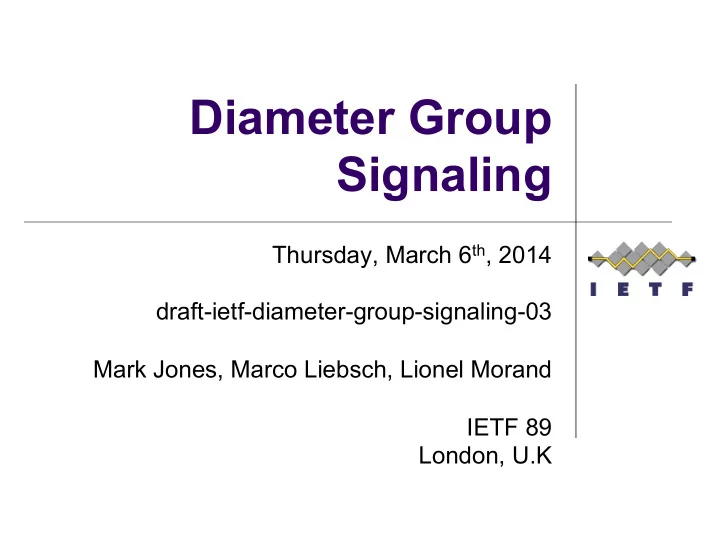

Diameter Group Signaling Thursday, March 6 th , 2014 draft-ietf-diameter-group-signaling-03 Mark Jones, Marco Liebsch, Lionel Morand IETF 89 London, U.K
Two Problem Aspects 1. Managing group assignments How to add or remove sessions from groups l Guidelines for modifying group assignments l 2. Manipulating groups of sessions Defines new AVPs for commands to enable group l operations
Summary of changes a per the 3 rd revision l Clarification of group ownership and the identification of a group owner l Clarification about permission considerations l Single section about protocol operation details l Error handling for group commands l Minor revision of flags in the Session-Group-Feature-Vector AVP l Dedicated section about considerations when proxy agents are present l Moved Authorization State Machine to the appendix as example
Group Ownership l A Diameter node, which creates a new group and assigns an unambiguous identifier to that group, is considered as the group owner l Group owner identified in the Session-Group-Id AVP l Default format must comply to the Session-Id AVP as per RFC6733 l DiameterIdentity element identifies the node, which owns the session group
Permission Considerations l Permission of a Diameter node.. l ..to add/remove a session from a group l ..to release a session group ID (tear down a session group) l This draft adopts the most flexible permission model l Any node can create a session group l Any node can add/remove a session to/from a group l Only restriction: Owner of a group can tear down a session group and release its group ID l More constraint permission considerations possible but out of scope of this specification
Protocol Description section l Single section about detailed ‘Protocol Description’ l combined Sec. 4 and Sec. 5 of previous draft l Simplified protocol operation l Indication of Client- vs. Server-assigned session group removed from Session-Group-Feature-Vector AVP l Group owner identified in an element of the Session-Group-Id AVP l Low constraints on session grouping l Each node can add/remove sessions to/from one or multiple groups
Error handling for group commands l Error in processing a group command applies to all sessions of one or multiple group à Appropriate protocol error must be returned to the sender à Sender falls back to single-session processing à All groups, for which the group command has been issued, must be closed (tear down) l Error in processing a group command applies to some sessions of one or multiple session groups à Result-Code AVP indicates DIAMETER_LIMITED_SUCCESS à Each session, for which the command failed, must be identified in a Failed-AVP AVP
AVP Format Session group identification and group control : l Session-Group-Info AVP (grouped) Session-Group-Feature-Vector (Unsigned32, interpreted as 32-bit flag field) l Session-Group-Id (OctetString) l Specified Session-Group-Feature-Vector values: SESSION_GROUP_ALLOCATION_ACTION (0x00000001) Identified session has been added to the session group (set) or is to be removed from the session group (cleared) SESSION_GROUP_STATUS_IND (0x00000010) Session group is active (set) or session group is to be released (cleared)
AVP Format Treatment of Group Commands: l Session-Group-Action AVP (Unsiged32) ALL_GROUPS (1) – Follow up exchanges should be performed with a single message exchange for all impacted groups. PER_GROUP (2) – Follow up exchanges should be performed with a message exchange for each impacted group. PER_SESSION (3) – Follow up exchanges should be performed with a message exchange for each impacted session. l Example: l Single ASR / ASA command applies to multiple groups l STR / STA to be performed per session (3) / per identified group (2) / once for all identified groups (1)
Presence of Proxy Agents ..current assumptions l Proxy Agent is group-aware l Proxy Agent must reflect the state of each session according to the result of a group command l In case the agent manipulates session groups, it MUST maintain consistency between client and server l E.g. Proxy and Server utilize session grouping, whereas the Client is not group aware
Open discussion items l Synchronization of session groups between Diameter nodes l One Diameter node can solicit a list of all session groups, to which a session has been assigned l Should this be covered by the specification? l Implicit capability discovery for group operations only as fallback in case no external capability discovery available l Minor editorial revision required l Proxy Agents are present – Current assumptions sufficient? l Any considerations about stateless Proxy and Relay Agents?
Next Steps l Solicit reviews and comments l Enter open items in issue tracker l Resolve issues and open items l Target WG LC after IETF90
Recommend
More recommend